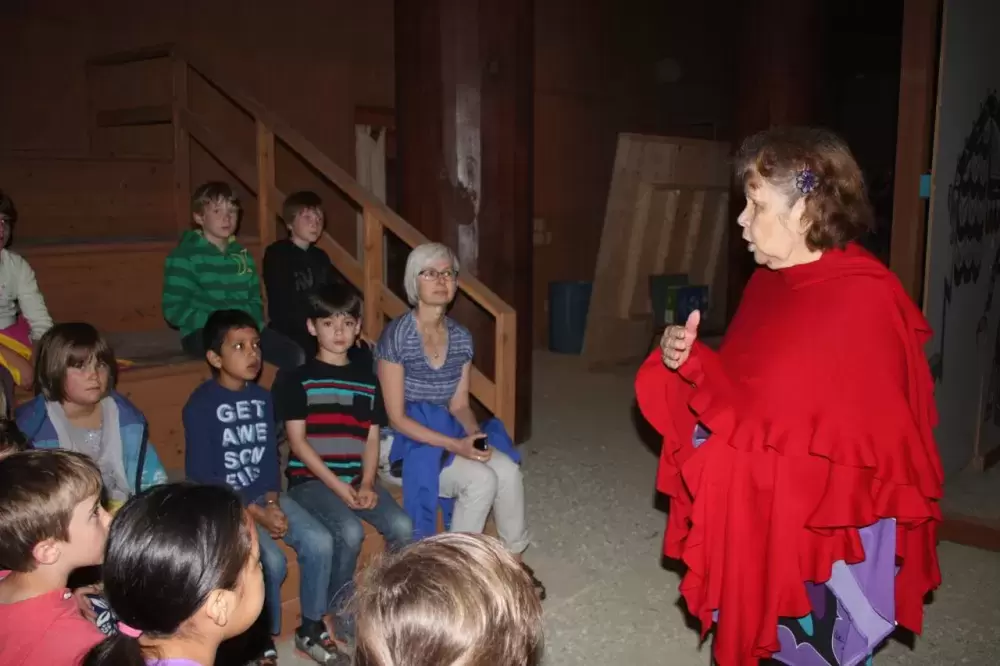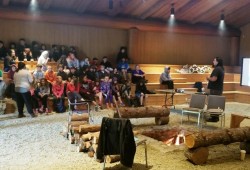Dozens of Alberni Valley school children visited the Tseshaht Longhouse May 30 for a chance to experience Nuu-chah-nulth culture through their indigenous studies program.
Nuu-chah-nulth Education Worker (NEW) Richard Samuel helped coordinate the activities with some of the other NEW staff. The experience allowed the children to take their lessons inside the Tseshaht Longhouse rather than the classroom. The replica longhouse is a windowless, wooden structure lined with wooden benches. In its center, an indoor fire pit sparks and crackles, providing warmth, smoke and dim light. It allows the students to experience how Nuu-chah-nulth-aht lived long ago.
SD 70, in partnership with NEW staff and Tseshaht First Nation has been delivering these unique field trips all year long. Samuel estimates that the schools have spent six school days in the Tseshaht Longhouse since the start of the school year with another six days to complete before the end of June.
On the morning of May 30, students from Alberni Elementary School’s Grades 2 and 3 class were welcomed to the longhouse by Tseshaht elder Willard Gallic.
With a fire crackling in the middle of the smoke-filled room the children were divided into two groups where they heard Nuu-chah-nulth stories from NEW staff Jean Thomas and Iris Sanders.
Story-telling in Nuu-chah-nulth culture usually feature characters from the animal world endowed with the ability to speak and think like humans. Their stories are often about life lessons that could be about sharing, cooperation or the importance of obeying elders.
Later that morning John Rampanen spoke to Grades 6 and 7 students about the colonization of the Nuu-chah-nulth territories. He started his presentation by sharing Nuu-chah-nulth history and legends.
He talked about how Raven worked so hard to steal light so that the world would no longer be dark. But Raven was too impatient and couldn’t restrain himself. He would disguise himself as a salmon or a berry in an effort to sneak into the village to steal the light box. But he always wanted to be the biggest and the best of everything he tried to disguise himself as, giving himself away to the people who only knew him too well.
Raven consulted with Wren and the two birds devised a plan that required time and patience in order to fool the keepers of the light. Eventually, Raven succeeded in stealing the light and brought it to the rest of the world, earning himself adoration and the first pick of seafood buffet on the beach at low tide.
“This is why raven is always first to the beach, because he earned it,” Rampanen told the students.
He went on to talk about Tseshaht creation stories and Nuu-chah-nulth whaling history, one that distinguishes them from other coastal First Nations. But the practice faded away when commercial whaling in the 1800’s decimated whale populations to near extinction.
The Nuu-chah-nulth Cultural Experience classes will run throughout the last week of May and early June.
According to A.W. Neill Elementary School Principal Darrin Olson, the topics were chosen as an introduction into local indigenous learning.
“In the winter months each went up to the longhouse and had a similar experience related to Tseshaht history, traditional plants and Nuu-chah-nulth history/governance for Grade 4/5 classes,” he said. We have expanded this opportunity to our Grade 2/3 students and Grade 6/7 classes, he added.
The direction of the new BC Curriculum is to integrate First Nations perspectives and history in all aspects of the subjects being taught.
“We feel that there is no better way to incorporate aboriginal teachings than in a local longhouse,” said Olson. “Our thanks and appreciation goes out to the Tseshaht people for the use of their facility.”








